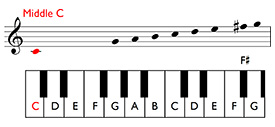5.3 Semitones and tones, and the scale of G major
We saw in the previous section that if we start at middle C and follow the T T S T T T S pattern we generate the scale of C major. Middle C (and any other C) in the C major scale is called the tonic or key note – it tells you the key. What if we start on a different note, a different tonic? If we begin on G instead and follow the same intervallic structure, we generate the following notes:
| G–A | Tone |
| A–B | Tone |
| B–C | Semitone |
| C–D | Tone |
| D–E | Tone |
| E–F♯ | Tone |
| F♯–G | Semitone |
The notes generated are the same as for C major, except for one. There is an F♯ instead of an F. (Example 43).
Example 43

The qualifying label, ‘sharp’, indicates that the note has been raised a semitone, and this is represented by the symbol, #, placed before the note and on the same line or in the same space as the note head. We needed to raise the F a semitone to F♯ because the interval required at this point in the pattern is a tone. E–F, as we know from our examination of the scale of C major, is only a semitone; we therefore need an additional semitone to make up the tone required by the pattern, T T S T T T S. And a tone above E is not F, but F♯.
Summary: tones, semitones and scales
- i.The intervallic structure for all major scales is T T S T T T S.
- ii.We can therefore use this pattern to generate a major scale starting on any note – after our examination of C major, we tried a G.
- iii.The major scales generated, apart from C major, will use a mixture of white and black notes on a keyboard.
